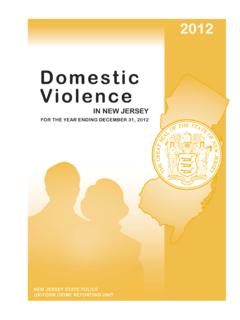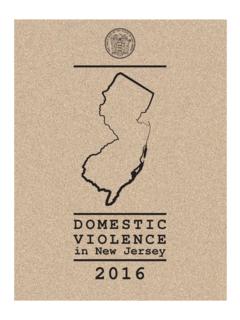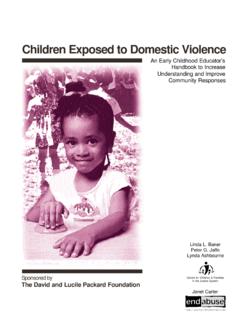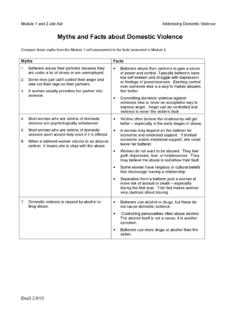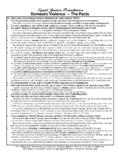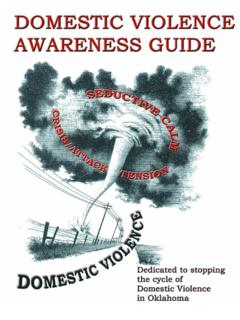Transcription of Assessing the risks to children - Barnardo's
1 Assessing the risks to childrenfrom domestic violence I feel a lot more confidentnow going out to visit afamily where there isdomestic violence . Social workerFindings from two pilot studies using the Barnardo s domestic violence RiskAssessment ModelJulie Healy and Madeleine BellNo. 7 Policy and practice briefingNo. 7 Policy and practice briefingAssessing the risks to childrenfrom domestic violenceFindings from two pilot studies using the Barnardo sDomestic violence Risk Assessment ModelThis briefing paper highlights the findingsfrom two pilot studies conducted in2004 by Barnardo s Northern Irelandwith three Health and Social ServicesTrusts in the Southern Health and SocialServices Board and the Ulster Community& Hospitals Trust. The two studiespiloted the use of a domestic ViolenceRisk Assessment Model which has beendeveloped by Barnardo s DomesticViolence Outreach Service1.
2 The findingshighlight the need for a specific assessmenttool to assist practitioners assess the riskspresented by domestic violence forchildren and make decisions about thetypes of interventions has been increasing recognition of the impact of domestic violencesituations on children and the need to assess these risks and plan effectiveinterventions. (McGee, 2000; Webster,2003). However in some Health andSocial Services Trusts, social workershave identified a gap in their knowledgeto assess the risks and identify supportsfor children in these situations. In 2004 Barnardo s was approached by the UlsterCommunity & Hospitals Trust (UCHT)and the Southern Health and Social 1 The model originates from Ontario, Canada and has beenadapted with their permission by Madeleine Bell,Barnardo s Northern Ireland children s Services Board (SHSSB) with a requestfor training to facilitate decision-making in domestic violence situations wherechildren are present.
3 Both agencies hadidentified a gap in their procedures toassess the risks posed to children bydomestic violence can take many differentforms and no two experiences are likelyto present in the same way. It is crucialthat social workers who are very likelyto encounter the issue in their work are competent in current practice andhave the essential knowledge base toidentify the risks and for domesticviolence situations wherechildren are presentThe Department of Health, SocialServices and Public Safety is in theprocess of establishing a multi-agencysingle assessment model for NorthernIreland. This is based on the Frameworkfor the Assessment of children in Needand their Families (DoH, 2000). Itprovides a generic framework forcollecting information about a family orsituation. However, as this is a generictool it is useful to have an additionalassessment tool to provide a robustassessment for situations where there isdomestic on extensive experience of usingand training others to use the DoHframework, Calder (2004) expressesconcern about the framework srobustness for domestic violencesituations where children are present.
4 Asthe assessment groups fathers andmothers together when looking atparental capacity, this can lead to adescription of violence as family violence rather than labelling the abuse as domestic violence . Jointly groupingparental capacity in this way can alsodetract from the very different rolesparents play (or fail to play) within afamily. In practice, the focus is all toooften on the mother s capacity to parentand protect rather than the perpetrator sabusive behaviour. This puts the onus ofthe child protection procedure on themother s ability to protect and not onthe perpetrator taking responsibility for his abusive assessmentframeworks in useResearch and training needs analysiswithin SHSSB and UCHT highlighted theneed for a specific risk assessment toolfor domestic violence Community & Hospitals TrustIn particular, research (Nicholl, 2001)within UCHT highlighted the followingconcerns.
5 Absence of clear policy and proceduresrelating to domestic violence evidence of inconsistencies in decision-making and recording in domesticviolence cases lack of clear categorisation into familysupport or child protection cases need for research and training on theimpact of domestic violence emerging from this research led to a number of recommendations for thefuture management of domestic violenceIt is important to note that the modelhas been designed specifically withmale to female violence in mind. Maleto female violence provides the focusfor this report, although we are awarethat female to male violence andviolence within same sex relationshipsalso occurs. Our knowledge aroundthe impact of these risks to childrenand methods of Assessing these risksmust be within the trust and training washighlighted as a priority for social workstaff dealing with domestic violence establishment of a set of criteriawhich would assist social workers in theirdecision making, particularly in regard to the classification of cases into familysupport or child protection, was alsorecommended.
6 In response to this, fundingwas obtained from the Eastern Health andSocial Services Board to facilitate trainingand a six month pilot Health and Social Services BoardThe Southern Board has implemented amulti-disciplinary assessment of theneeds of children and their families. Thisis based on the Framework for theAssessment of children in Need andtheir Families (DoH, 2000). In caseswhere there are child protectionconcerns the board implements aseparate Risk Analysis Model2. Howeverthe board felt that staff would benefitfrom training on a specific tool to assessrisks and help inform decision-making oncases with children living in domesticviolence impact of domesticviolence on children policy and proceduresBoth SHSSB and UCHT use a policy andprocedure guide when presented withincidents of domestic violence in familieswith children .
7 Within these policies socialworkers are responsible for Assessing riskand making decisions about the childprotection issues presented by domesticviolence. However there are no explicitinstructions to guide how these risks areassessed. At the outset of the two pilotstudies, it was hoped that the Risk2 This Risk Analysis Model is the result of a collaborationbetween the Southern Area Child Protection Committeeand Greg Kelly at the School of Social Work, QueensUniversity & Mourne HSST, Armagh & Dungannon HSSTand Craigavon & Banbridge Community HSST4 Reference,Policy and practice briefing, : SupportingChildren in a domestic violence Situation,Summary of Issuesand Findings from the domestic violence OutreachService (DVOS).Assessment Model would provide staffwith the tools and a framework to carryout assessments and implement supportin an informed and consistent and pilotprogrammesIn September 2003 Barnardo s NorthernIreland domestic violence OutreachService provided two, two-day trainingsessions, one for four social work teamsfrom three Health and Social ServicesTrusts3in the Southern Board area andanother for four teams in UCHT.
8 Thiswas followed by a further day s training on Safety Work for women and childrenexperiencing domestic violence4. Themain focus of the training was the use ofthe domestic violence Risk AssessmentModel and to examine the complexityand dynamics involved in domesticviolence situations and the impact of thison children . It was agreed that staff whohad participated in the training wouldimplement the model during a six monthperiod to pilot its use. From the threeSouthern Board Trusts, seven socialDomestic violence RiskAssessment ModelThe model used by the Barnardo sDomestic violence Outreach Scheme(DVOS) originates from Ontario,Canada. Based on experience gainedfrom using the model in the DVOS, asystem of threshold scales, risk factors,potential vulnerabilities and protectivefactors have been added to the modelenabling comprehensive analysis ofrisk within the assessment model is used to assess theseverity of risk posed by domesticviolence within families where childrenare present.
9 It aims to help practitionersmake decisions about the riskspresented for children and to planeffective interventions for the model is based on the followingprinciples: protecting the children is the firstpriority protecting the non-abusing parent usually the mother helps protectthe children providing supportive resources tothe non-abusing parent will helpprotect and care for the children holding the perpetrator responsiblefor the abusive behaviour respecting non-abusing parents right to direct her own life withoutplacing her children at increasedrisk of further abuse from Risk Assessment Model has nineassessment areas. These are the keyareas to assist social workers andother childcare professionals reachdecisions about when a child is inneed or is in need of protection .The nine assessmentareas are: nature of the abuse risks to the children posed by theperpetrator risks of lethality perpetrators pattern of assault andcoercive behaviours impact of the abuse on the women impact of the abuse on the children impact of the abuse on parentingroles protective factors the outcome of the women s use these areas toidentify and collect information onwhich to base their information can then be used toidentify gaps in our knowledge aboutthe situation and also to begin aprocess of Assessing the , five team leaders, twoprofessional support and servicedevelopment officers and one principalsocial worker took part in the pilot.
10 Fourteams participated in UCHT totalling 18social workers, four team leaders and twoassistant principal social workers and oneprogramme scalesThe model rates the severity of risk usinga threshold scale. This scale rates from 1(minimum risk) to 5 (serious risk).Threshold scale 1 assess minimum riskfrom domestic violence . Usually used forfamilies where there is verbal aggressionor the care giver has experiencedprevious abusive relationships. Familysupport may be scale 2 to 3 assesses thedomestic violence risks as moderate andfamily support is deemed the appropriateintervention. These scales specificallyaddress the grey areas in makingassessments and decisions around therisk presented by domestic scale 4 to 5 assesses theseverity, nature and impact of thedomestic violence abuse as high risk .A threshold of significant harm is reachedand child protection procedures risk assessment process clearly setsout any risk or potential risks posed tothe family as a result of domestic violencewhilst taking account of other issuesimpacting on the family.












